6 Syllable Types: Everything to Know & Examples
This post may contain affiliate links. As an Amazon affiliate, we earn from qualifying purchases.
Learn all about the 6 syllable types in the English language: Closed, Open, Magic E, Vowel Team/Diphthong, R-controlled, and Consonant+le. Knowing these types of syllables will help readers decode and spell words with accuracy! Get lots of examples of each syllable type, plus get a FREE printable pdf chart with graphics for reinforcement.
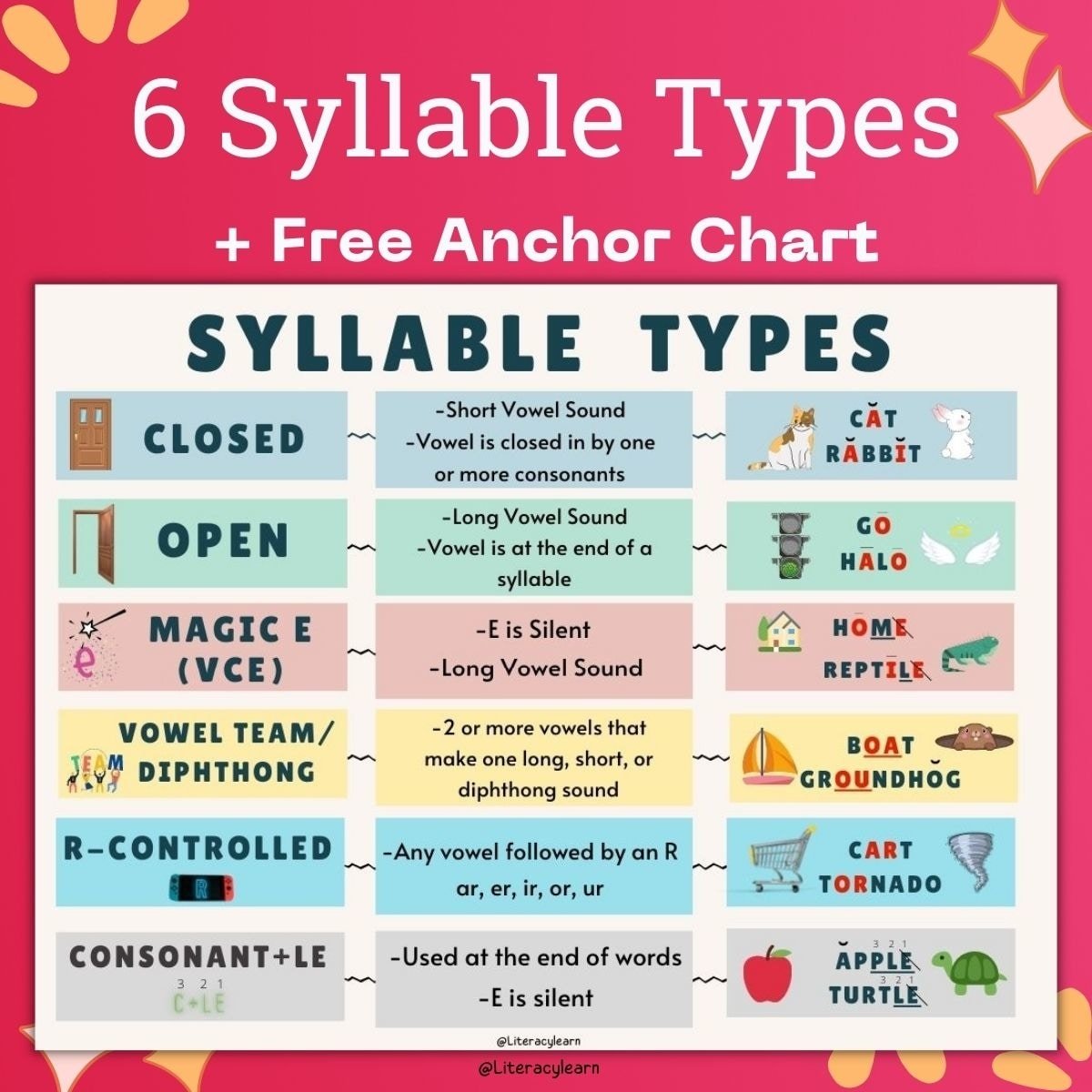
Are There 6 or 7 Syllable Types?
According to Webster’s Dictionary, a syllable is, “A letter, or combination of letters, uttered together, or at a single effort or impulse of the voice.” It is important to note that every syllable must include a vowel!
And if you’re just learning about syllable types, you may wonder, are there six or seven syllable types?
All experts agree that there are at least 6 syllable types in English:
Some popular programs and prominent leaders in the field of reading include a seventh syllable type called a Diphthong Syllable.
Diphthongs are glided vowels (like oi or ow) where one’s mouth glides when saying the sound. However, it is perfectly acceptable among language experts to combine vowel team and diphthongs and consider them one syllable type.
Noah Webster, the man who regularized syllables for the first American English dictionary, recognized only six syllable types. Plus, children today don’t necessarily need to know the difference between a vowel team and a diphthong.
For all intents and purposes, vowel team and diphthongs syllables can be combined and recognized as the same. For these reasons, we will stick with “Webster’s Way” and refer to only six syllable types.
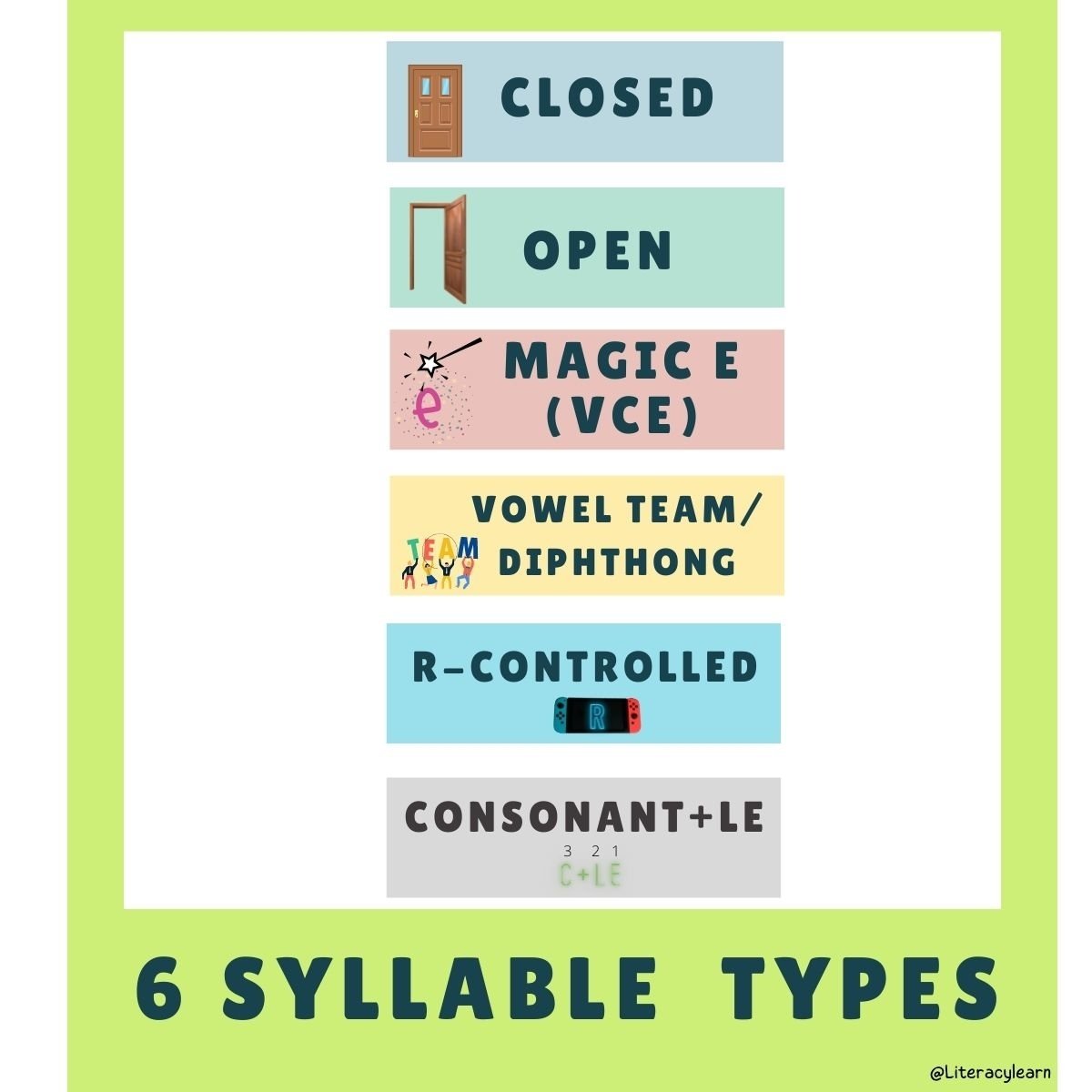
Teaching Syllable Types
Why is it important that students know syllable types? It adds powerful tools to every reader’s toolbox!
Knowing syllable types helps students in two key ways:
- It helps children break words into smaller, more manageable parts. This allows them to correctly pronounce and read longer, multisyllabic words.
- It helps children spell. They explain spelling generalizations, like doubling consonants or dropping the e.
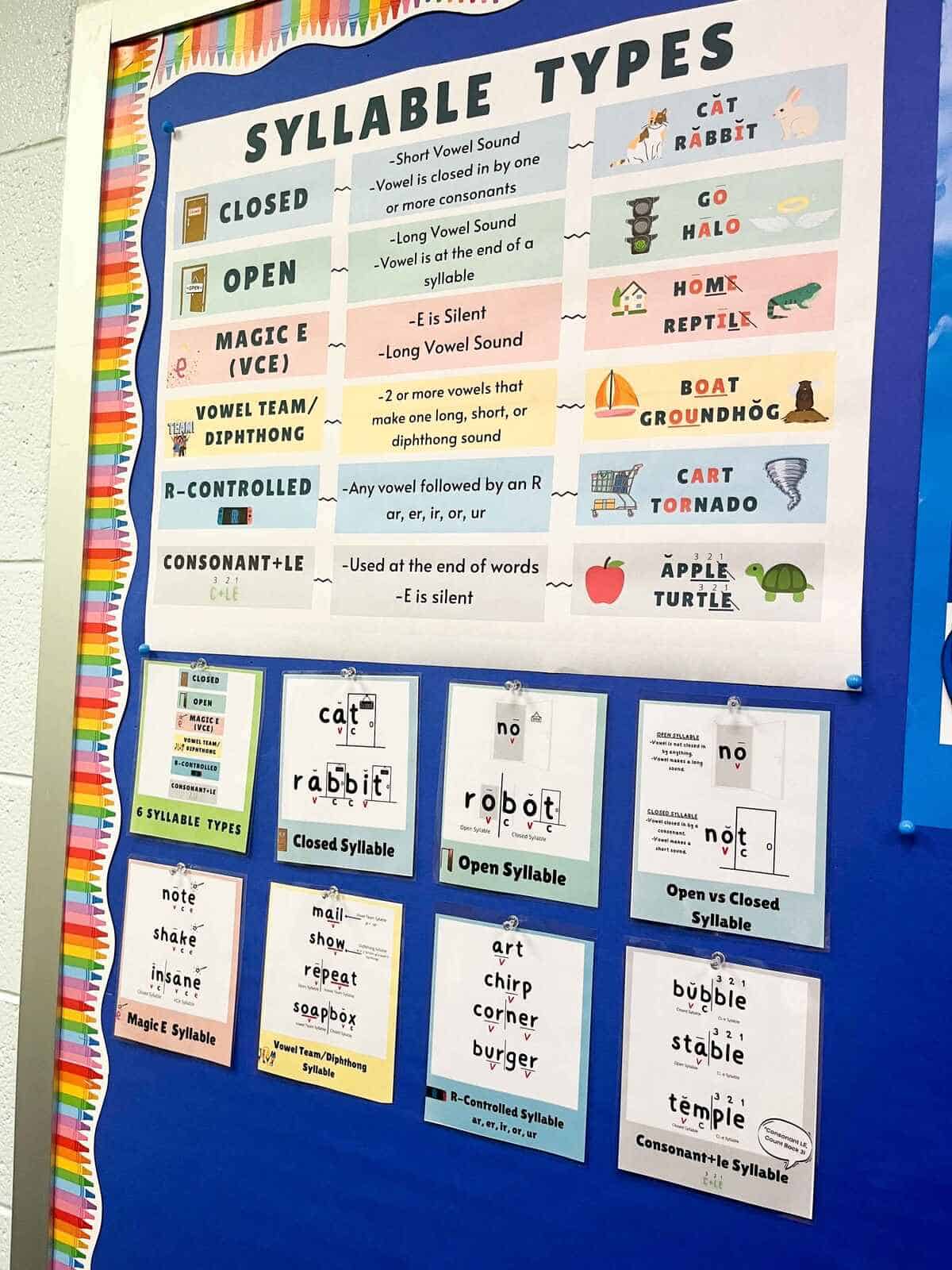
This gives kids a solid understanding of our language system and helps them to quickly determine the vowel sound in each syllable. Ultimately, it helps lead children to better decoding and spelling skills and equips young readers for success.
Follow a systemic plan for teaching phonics skills in order to introduce syllables (I use Recipe for Reading). Ideally, teaching closed and open syllables should begin at the end of kindergarten (when teaching CVC words) and continue on through 3rd grade.
The progression should continue with magic e vowel teams, r-controlled, and consonant+le throughout first and continued into second grade and third grade. If you work with older students, you can quickly cover these syllable types and provide intervention as needed based on the deficits you assess.
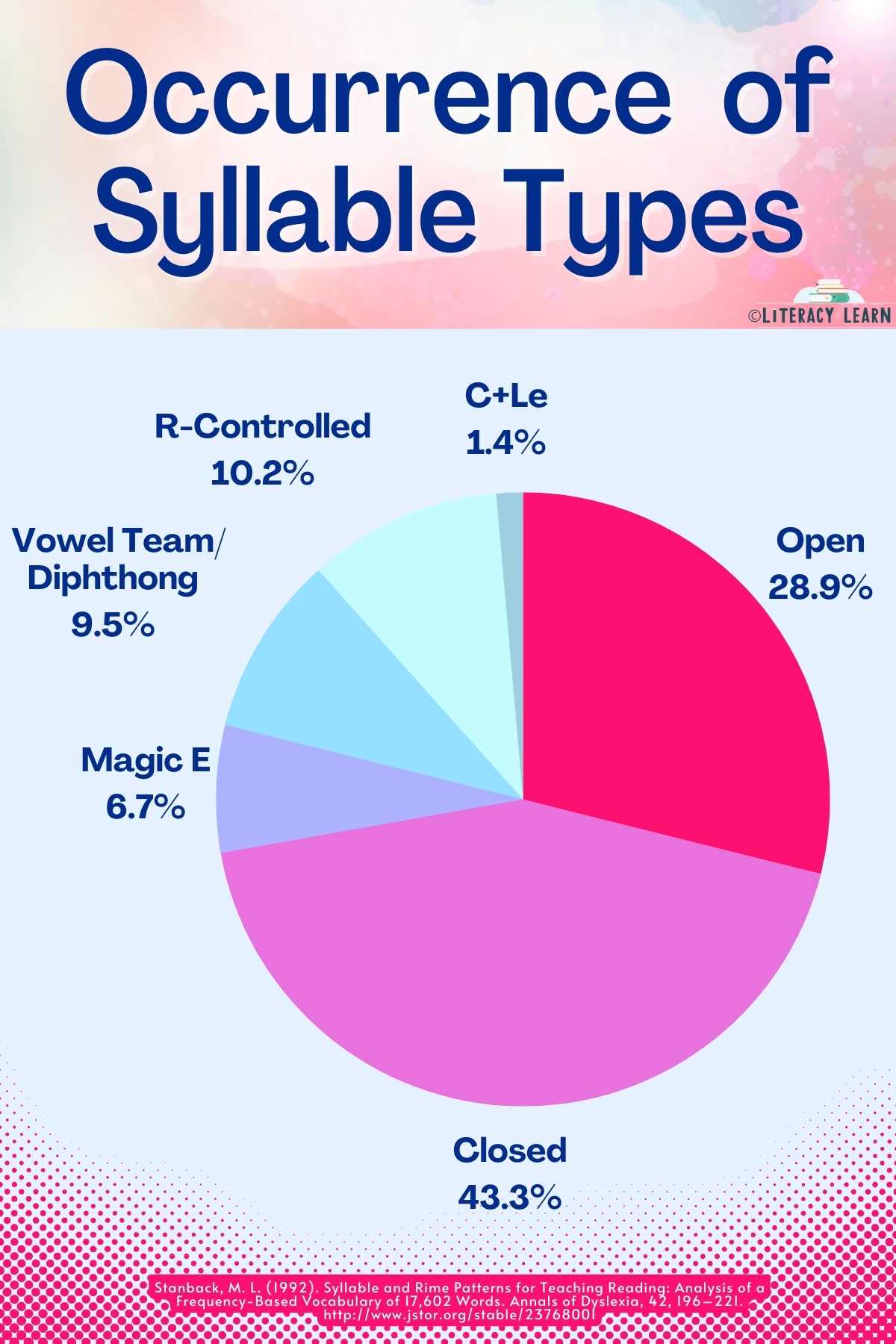
Examples of Syllable Types
Below we’ll outline the six kinds of syllables in English and provide lots of clear examples. These include closed, open, magic E, vowel teams/diphthong, R-controlled, and consonant+le.
Closed Syllable
A closed syllable includes one vowel, and the vowel is closed in by one or more consonants. The vowel will be short.
Imagine a closed door. When the consonant ‘closes in’ the vowel, it makes the vowel short.
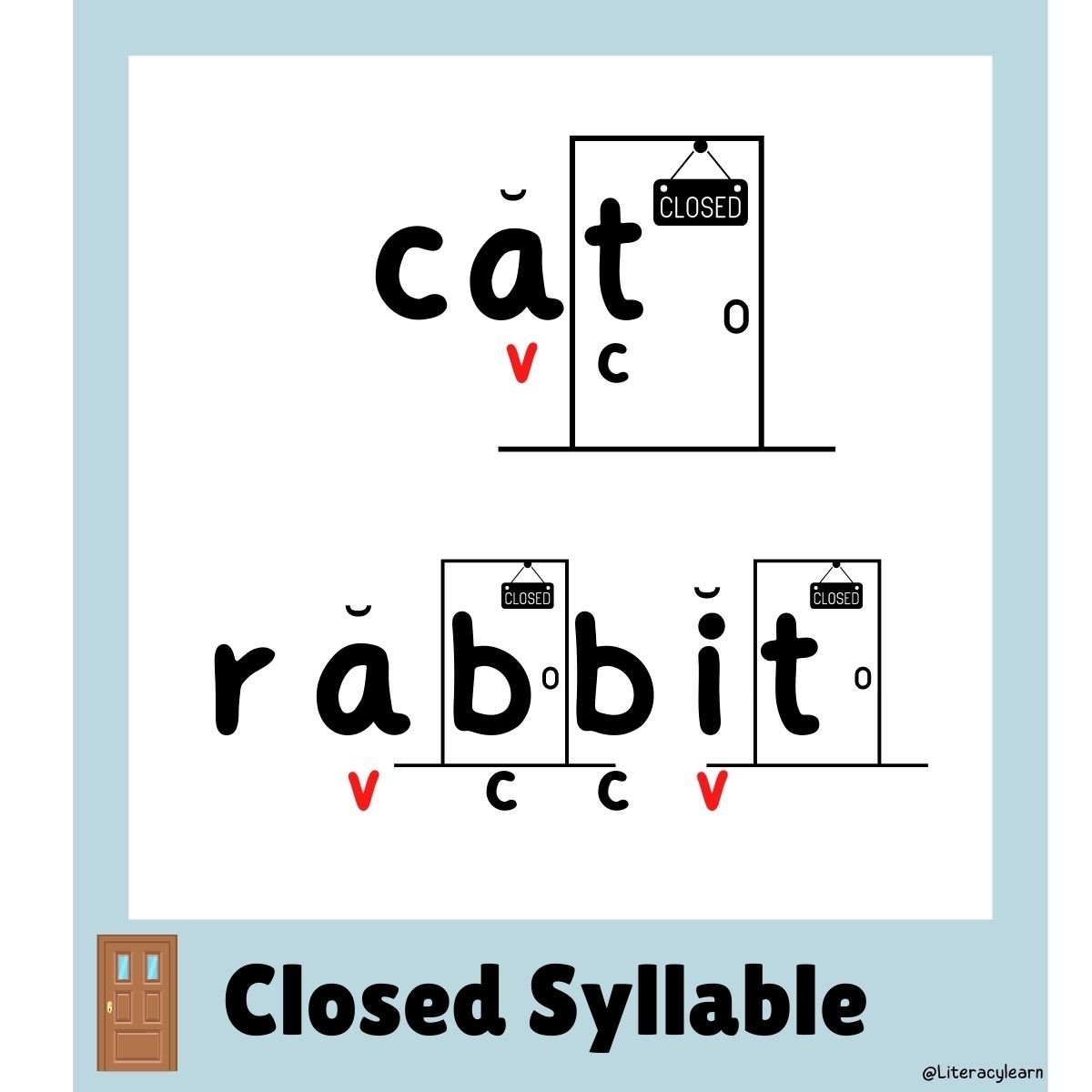
🚪 Closed Syllable Word Examples:
- One syllable Words: cat, pet, hit, on, hush, and, red, lip, chin, hatch, fudge, pick, jazz, chuck.
- Two Syllable Words: fos/sil, bon/net, pub/lic, com/plex, ab/stract, jack/pot, bed/bug, trel/lis.
- Three Syllable Words: fan/tas/tic, At/lan/tic, in/cum/bant, in/trin/sic, dis/con/nect, ap/pen/dix
In a study of over 17,000 common English words, Margaret Stanback (1992) found that over 43% of syllables in English are closed syllables, so it’s important for kids to master this syllable type first.
- To learn more about closed syllables and how to teach them (plus 3 free worksheets to practice) visit this post on closed syllables.
- For a free printable with 80+ closed syllable words, organized by short vowels, visit this post on closed syllables.
- For 4 free printable lists of multisyllabic closed syllable words, visit this post on VC/CV words.
Open Syllable
An open syllable is a syllable that ends in a vowel. Because no consonants are closing in the vowel, the syllable is open and the vowel will be long.
Knowing the rules of these first two syllable types will tell a child how to read the word ‘robot’ word correctly.
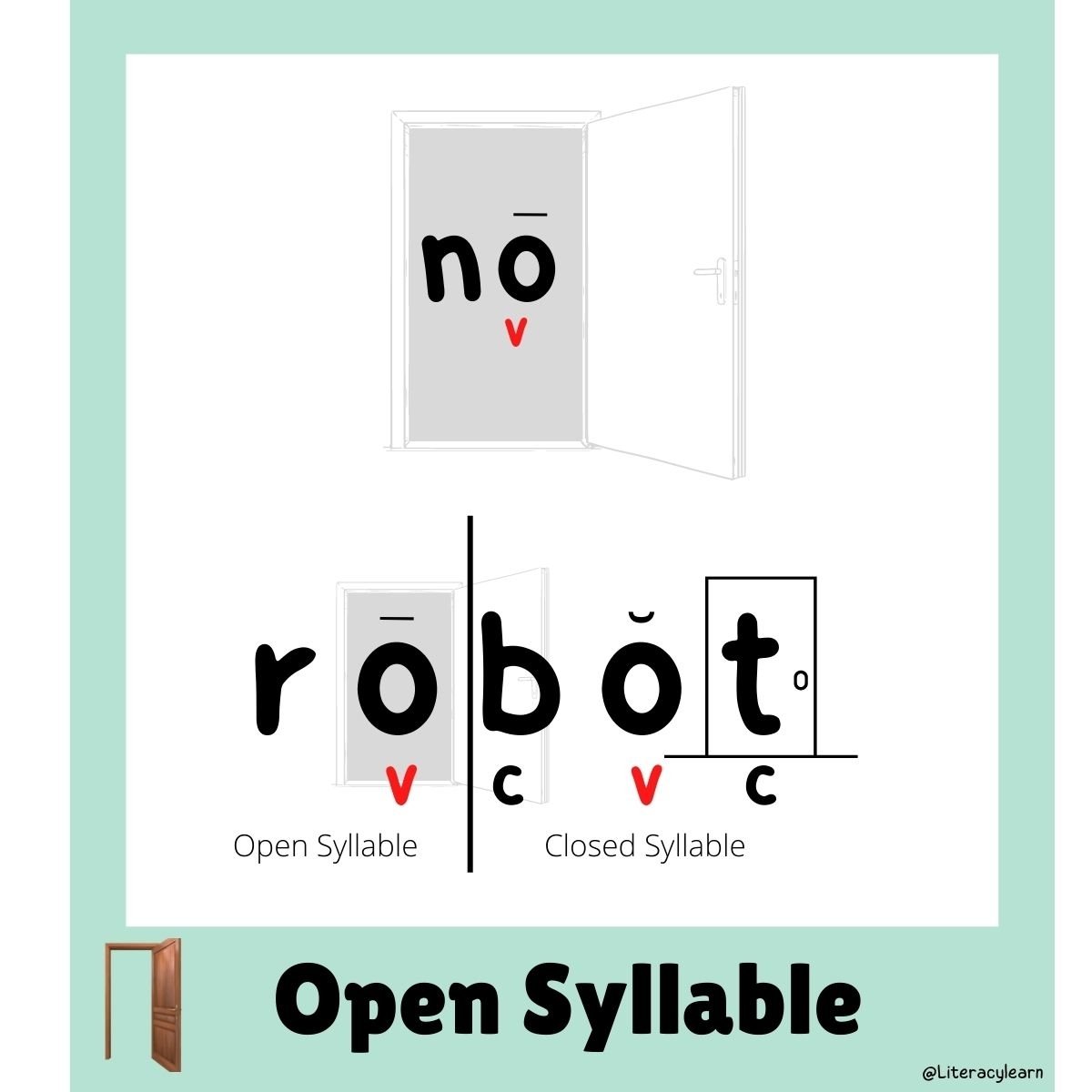
- ro is an open syllable = long vowel sound.
- bot is a closed syllable = short vowel sound.
- Put them together and read robot! 🤖
In the same study mentioned above, Stanback (1992) found that about 29% of syllables in English are open syllables.
Readers need to be able to identify this prevalent syllable type beginning in first grade as they learn long vowel sounds.
👐 Open Syllable Word Examples:
- One Syllable Words: no, go, l, me, be, yo, dry, he, sly, why, she, me, so.
- Two Syllable Words: a/go, ro/dent, car/go, pro/tect, ba/con, o/ver, so/lo, ra/zor, u/nit.
- Three Syllable Words: ro/de/o, u/til/ize, vi/o/lin, pi/o/neer, po/ta/to, i/o/dine, I/o/wa, ra/di/o.
👉 Learn more about open and closed syllables, with tips on how to teach them and 3 free worksheets to practice.
👉 Get our free printable open syllables list with 64+ open syllable words, organized by 1, 2, and 3 syllables.
👉To learn more about the long vowel sounds that the letter Y can represent in an open syllable, visit our post that discusses Y as a vowel.
Open and closed syllables together account for nearly three-fourths of syllables represented in English words. Stanback (1992) says, “The other syllable types, although they occur relatively less often, are still found in large numbers of words.”
Magic E (VCe) Syllable
Magic E syllables are syllables that follow the Vowel-Consonant-E pattern. This is why they’re sometimes called VCe syllables. They can also be called Silent E syllables or Bossy E syllables. These VCe syllables are found at the end of syllables or words.
In these syllables, the E has two jobs:
- The E stays silent! 🤐
- It jumps back over one consonant and makes the vowel says its long sound (or its name).
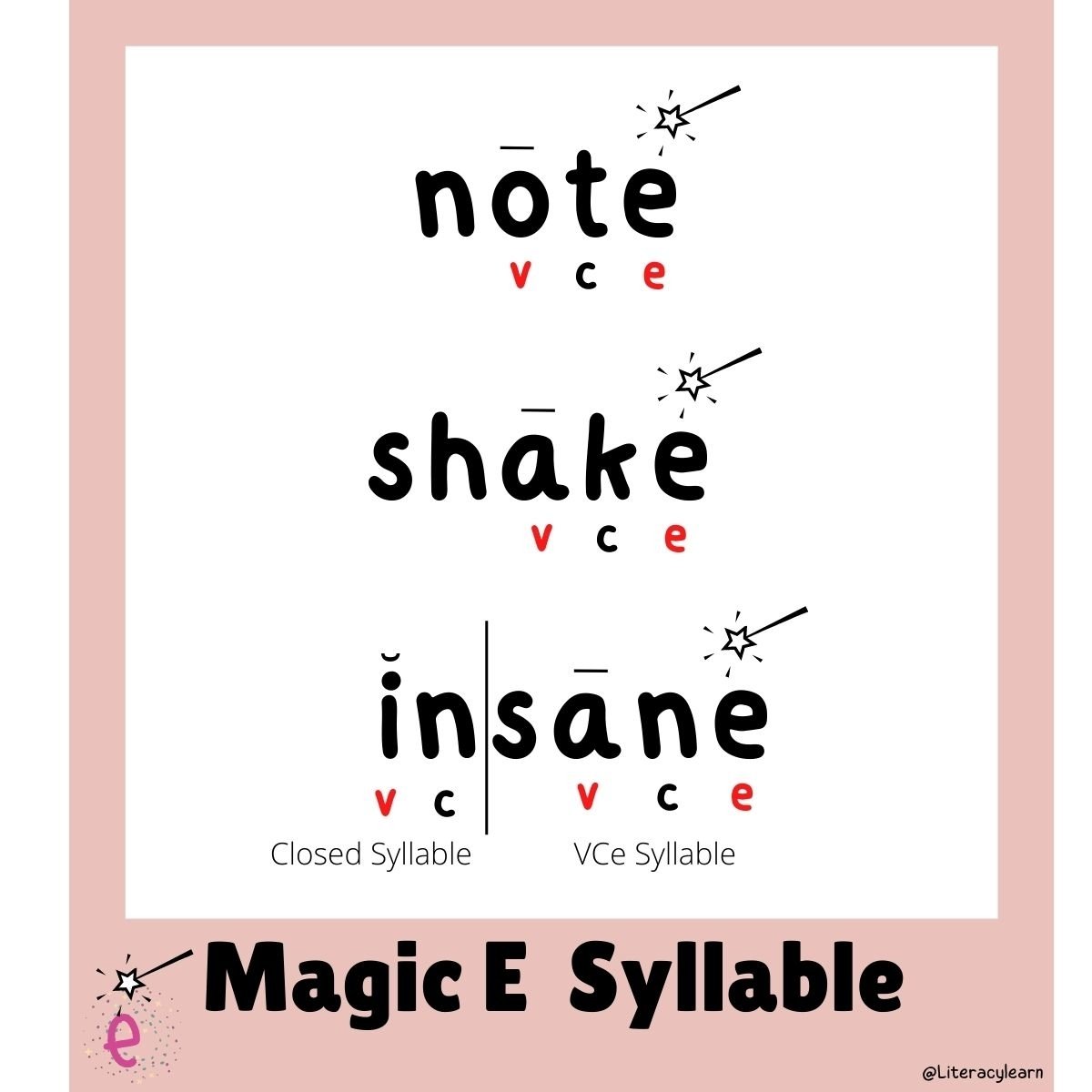
🧙♀️ Magic E (VCe) Syllable Word Examples:
- One Syllable Words: tape, here, tile, home, puke, ape, Pete, pipe, mule, theme, cave, hose.
- Two Syllable Words: in/side, e/lope, ex/clude, ig/nite, tad/pole, mis/take, land/scape, cup/cake.
- Three-Syllable Words: in/cub/ate, en/vel/ope, il/lus/trate, su/per/vise, lem/on/ade, an/te/lope.
👉 Get our free printable with 75+ VCe words with pictures, organized by long vowels.
👉 For additional multisensory practice with one syllable VCe words, use these free and fun Magic E Wand Printables.
👉 These Silent E worksheets are great to reinforce VCe words, and include both one and two syllable words.
Vowel Team/Diphthong Syllable
In the vowel team/diphthong syllable, the vowel team or diphthong functions as the vowel within that syllable.
A vowel team is two vowels working together to make one sound. Common examples are: ai (ā), ay (ā), ee (ē), ea (ē), oa (ō), oe (ō), ow (ō), and ew (ū).
A diphthong is a gliding vowel. It’s called gliding because the mouth starts at one position and moves to another as the sound is made.
Try it with these diphthongs: aw/au, ew/oo, oi/oy, ow/ou. Sometimes, the letter ‘w’ or ‘y’ teams up with a vowel to create a diphthong.
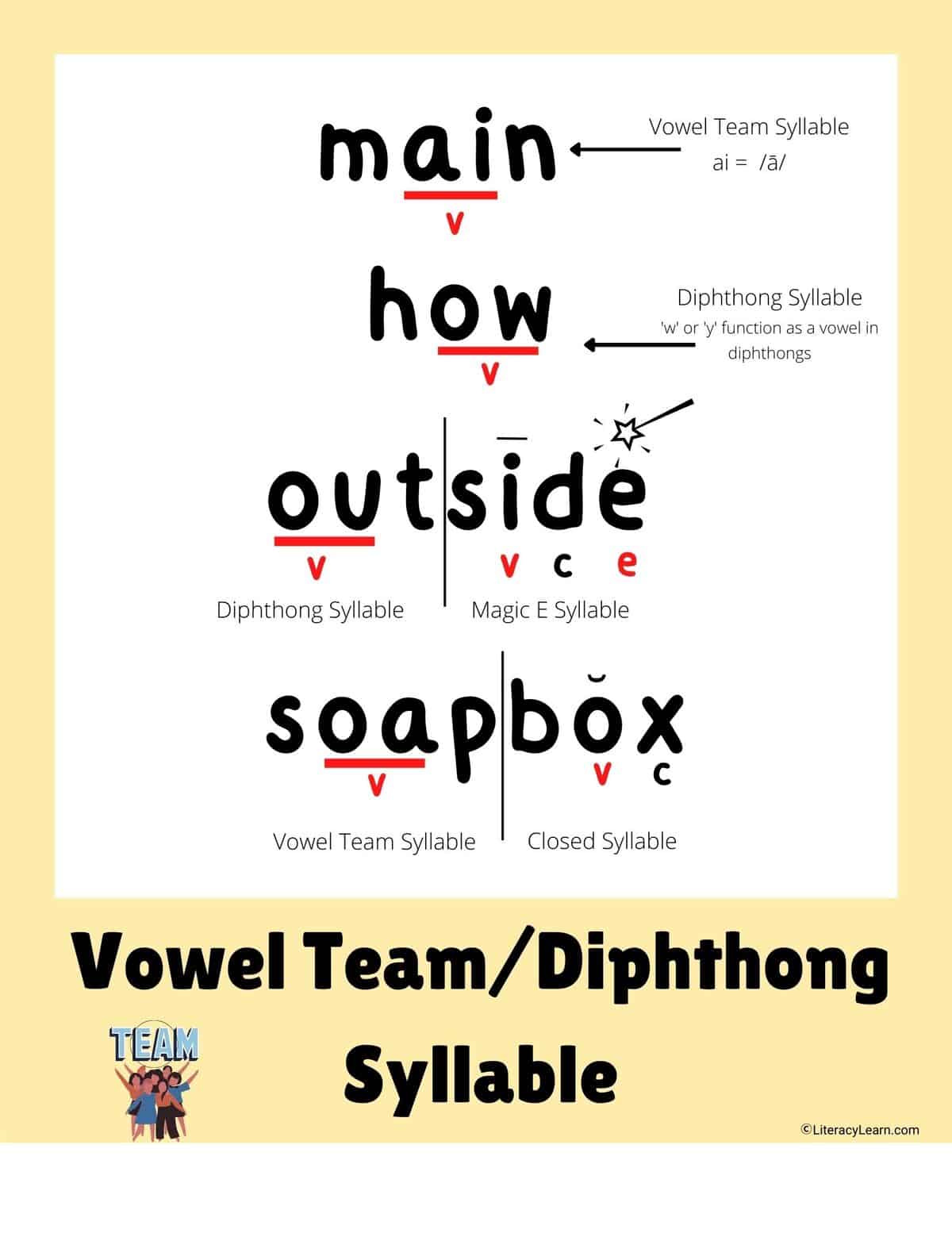
Vowel Team/Diphthong Syllable Examples:
| ai | ay | ee | ea | oa | oi | ou | au | aw |
| sail | say | see | eat | boat | coin | out | taut | saw |
| jail | Jay | speed | mean | coal | boil | loud | haul | jaw |
| stain | slay | reef | team | goal | join | our | laud | law |
| paint | pray | Greece | beat | load | avoid | couch | Paul | raw |
| rain | sway | week | please | moan | hoist | ouch | gaunt | slaw |
| stay | heel | seam | soak | noise | flour | fraud | straw | |
| bail | tray | speech | meat | coast | oink | pouch | haunt | flaw |
| pro/claim | be/tray | ex/ceed | ap/peal | toast/er | ex/ploit | out/er | au/dit | de/claw |
| do/main | dis/play | can/teen | real/ly | bloat/ed | un/coil | coun/ter | be/cause | out/law |
| sus/tain | a/way | de/gree | teach/er | soap/box | toi/let | out/rage | au/to | see/saw |
Get FREE decodable passages for practice reading words with vowel teams and diphthongs in context!
R-Controlled Syllable
An R-Controlled syllable has a vowel followed immediately by the letter R. The letter R controls the vowel and creates a new sound. R-Controlled vowels do not say their long or short sound. These syllables are sometimes called Bossy R Syllables.
Children will need to recognize the Vowel + R within the syllable and know the new sound that is created.
- Ar says /ar/ like car.
- Er, Ir, Ur all say /ər/ like her, bird, or nurse.
- Or says /or/ like corn.
The R-Controlled vowels can be found at the beginning, in the middle, or at the end of a syllable.
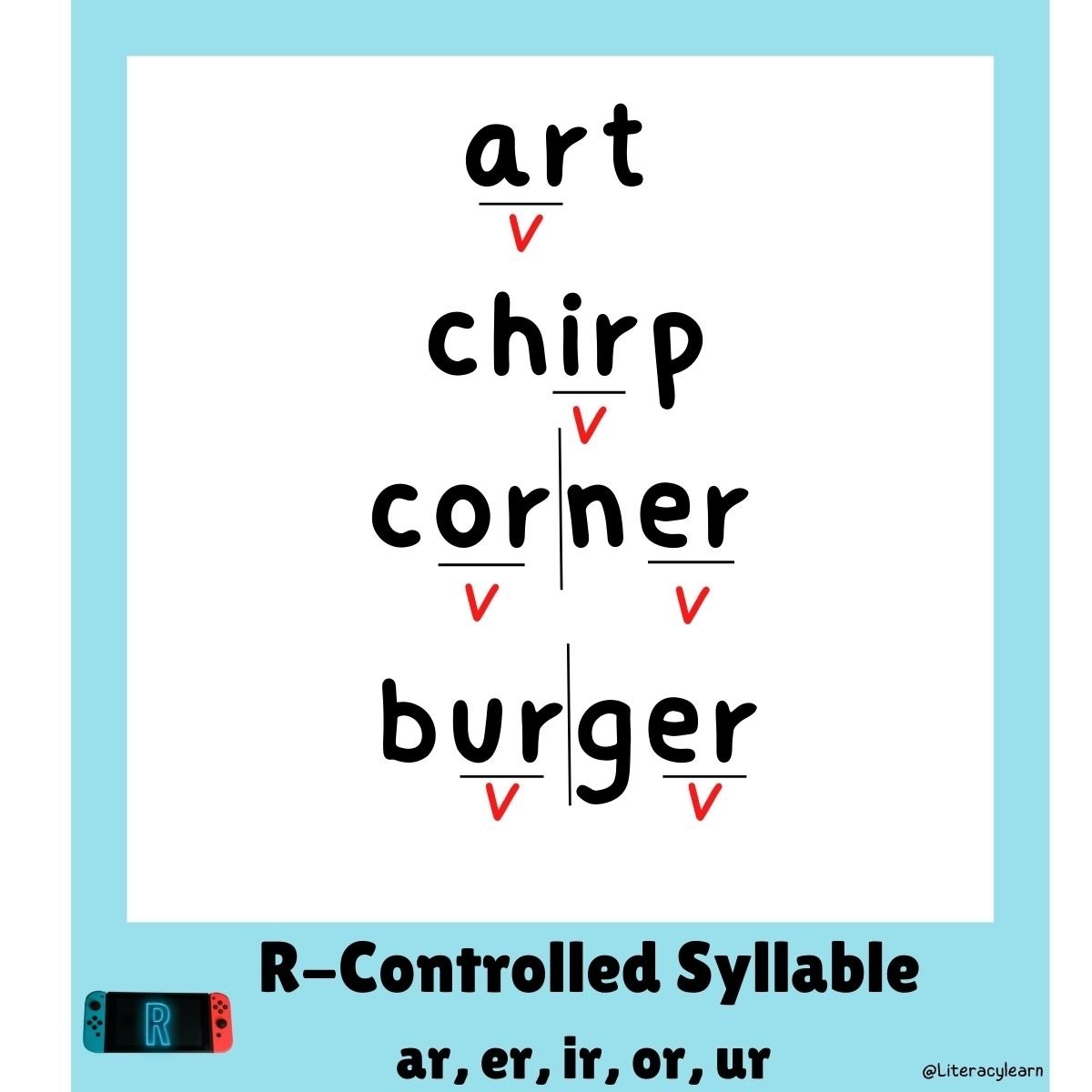
® R Controlled Syllable Examples:
- One Syllable Words: car, her, bird, corn, nurse, art, hurt, curl, Bert, sir, arm, firm.
- Two Syllable Words: stut/ter, car/pet dirt/y, tur/key per/fume, west/ern, tar/get.
- Three-Syllable Words: Am/ster/dam, sus/pen/ders, chat/ter/box, vet/er/an.
👉 Get our printable list of 150+ Bossy R words organized by vowels and syllables.
👉 Get 4 R Controlled worksheets to help reinforce R-controlled syllables and include both one and two-syllable words.
Consonant+le Syllable
This syllable type occurs at the end of a syllable. The consonant+le is its own syllable. The -le will make the /əl/ sound, which sounds like /ŭl/.
Common examples of consonant+le syllables that appear at the end of multisyllabic words are -ble, -dle, -tle, -gle, -ple, -fle, -kle, -cle.
The jingle students say for this syllable type is, “Consonant+le, Count back three.”
👉 Get our free printable c+le word lists.
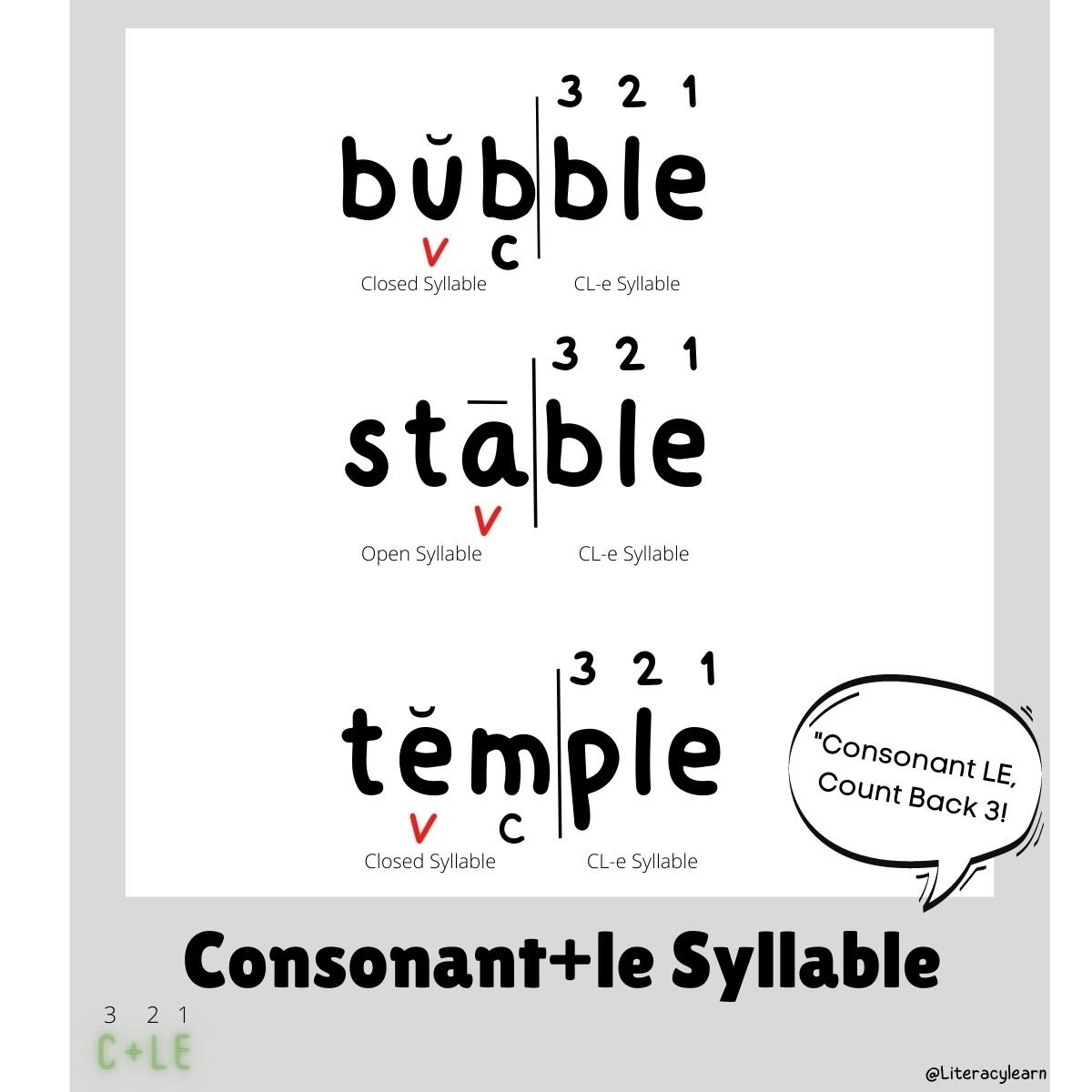
Knowing this syllable type helps students in a variety of ways. First, they’ll always know where to break the word to divide into syllables. They’ll look for the pattern, consonant+le, and then count back three. That’s where they’ll break the word.
Next, it will help students when spelling words. Knowing this consonant type tells us whether or not the middle consonant is doubled
Example: bub/ble must have two b’s in the middle, otherwise, the first syllable would be open and it would say bū/ble.
Consonant+LE Syllable Examples:
- a/ble, rid/dle, lit/tle, bog/gle, ap/ple, ri/fle, pic/kle, crin/kle, un/cle, pan/han/dle, as/sem/ble
Tips & Info
- Download our free chart below, and use it as an anchor in your classroom! For best results, print 18 X 24 or larger.
- You can also print it on standard-sized paper and staple it into your student’s phonics notebook for a quick reference or cheat sheet to use when reading or spelling words.
- Looking for more to help make your teaching easier? Check out our Syllable Bundle on TPT!
- Many statistics presented in the post come from this article: Stanback, M. L. (1992). Syllable and Rime Patterns for Teaching Reading: Analysis of a Frequency-Based Vocabulary of 17,602 Words. Annals of Dyslexia, 42, 196–221. Retrieved from: http://www.jstor.org/stable/23768001.
Printable Anchor Chart
We’d love to hear about your experience using the anchor chart or your feedback on this post! Please leave a comment below or tag us on Instagram @literacylearn.
DOWNLOAD TERMS: All of our resources and printables are designed for personal use only in homes and classrooms. Each teacher must download his or her own copy. You may not: Save our files to a shared drive, reproduce our resources on the web, or make photocopies for anyone besides your own students. To share with others, please use the social share links provided or distribute the link to the blog post so others can download their own copies. Your support in this allows us to keep making free resources for everyone! Please see our Creative Credits page for information about the licensed clipart we use. If you have any questions or concerns regarding our terms, please email us. Thank you!

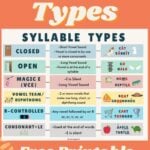

I have a question, Could you explain, please! Thanks so much!
I wonder why you said that close syllable is a short vowel, and after short vowel is a consonant, so we can double consonant to make close syllable.
But the CAMEL WORDS -CV/C (ex: Camel, magic, seven,…) is belong to short vowel, and we don’t double consonant in the middle instead of we only make “/”.
So I wonder why we learn close syllable while we don’t see a difference between close syllable and open syllable???
Hi Yen,
That’s a good question! Doubling the middle consonant ensures that the first syllable is closed. If there is a VCV pattern, then it can be open (V/CV) or closed (VC/V). And more often than not, the V/CV (tiger) pattern is more common than the V/CV (camel). You can check out our posts on Camel and Tiger words here. Let us know if you have further questions!
Katie and Laura
Am I correct in thinking vowel team syllables can be open and closed?
eg. toi let. Where t oi is open.
true. ue is open
break. is closed
Also, they can be short or long vowel sound.
deaf. Short vowel sound.
leaf. Long vowel sound.
Thank you
Heather
Hey Heather,
Vowel team syllables are considered their own syllable type, and are different from open and closed. The syllable “toi” is a vowel team, because the diphthong ‘oi’ serves as the vowel in the syllable. The word “true” and “break” are also vowel team syllables, because the ‘ue’ and ‘ea’ are vowel teams and make their own vowel sounds. Open syllables have long vowel sounds. Closed syllables have short vowel sounds. of course, there are always exceptions. But generally if there is a vowel team, the word or syllable would be considered a vowel team syllable. Hope that helps!
Katie & Laura
Katie,
OG teachers need to look no further for excellent resources! I especially like how you provide concise, clear directions for using the materials and teaching tips. You provide so much background information for each skill. It is obvious you have a teaching background!
I plan to make smaller copies of my students to glue into their notebooks as a reference for syllable division.
Sandra,
Thank you for the kind feedback! That made our day 😉
Katie and Laura
Hello, Thank you for the very helpful information. I do have a question about two examples in the silent e… 3 syallblel word examples. The example words incubate and envelope were confusing to me. Would you help me to understand the division marks for those words and how they follow the rule? in /cub/ate vs in/ cu/ bate and en/vel/ope vs en/ve/lope
Thank you, Julie
Hi Julie,
We are happy to help explain. You divide the words based on patterns and based on pronunciation.
In/cu/bate = in (closed), cu (open), bate (magic E)
En/vel/ope = en (closed), vel (closed), ope (magic E).
The consonant before the VCe (vowel/consonant/e) doesn’t determine the vowel sound in the VCe syllable.
Let us know if you have any additional questions.
Katie and Laura
Thank you for this clear information. I am reviewing syllable types with my 2nd ,3rd, and 4th grade intervention groups this week. This will help my instruction. I love the anchor chart too. I saw somewhere a smaller card that showed the difference between closed and open syllables .. now, I cannot find it. It was the size of the individual syllable type example cards. Can you send it to me
Hi Francis,
We are so glad to hear that these resources are helpful to your small groups! UPDATE: The high-res printable posters are live in our TPT shop!
-Katie and Laura.
Thank you for all this great,clear, useful information to support teaching syllable types! These resources are terrific!
Hi Cindy! It’s our sincerest pleasure to share this info! Thank you so much for the kind and encouraging feedback! -Katie & Laura